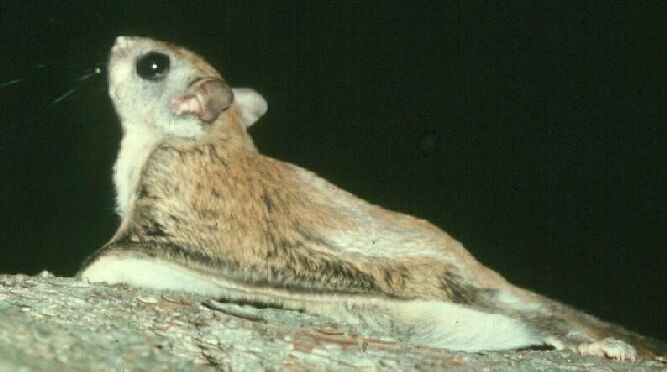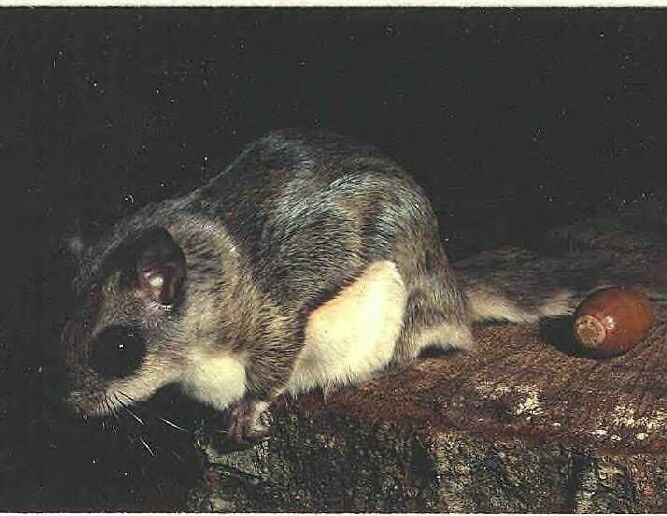Northern Flying Squirrel The northern flying squirrel, the largest and rarest of West Virginia's two flying squirrel species can be distinguished from the southern flying squirrel by its larger size; the gray base of its ventral hairs as opposed to a white base in the southern species; the relatively longer upper tooth row; and the short, stout baculum (penis bone) of the males. The northern flying squirrel, the largest and rarest of West Virginia's two flying squirrel species can be distinguished from the southern flying squirrel by its larger size; the gray base of its ventral hairs as opposed to a white base in the southern species; the relatively longer upper tooth row; and the short, stout baculum (penis bone) of the males.
West Virginia northern flying squirrels (Glaucomys sabrinus fuscus) are small nocturnal animals, covered with soft, dense, silky fur that is brownish above and grayish beneath. Individuals are about a foot long, half of which is the broad, flat tail, and weigh less than five ounces. Juveniles have uniform dark, slate-gray backs, and off-white undersides. These squirrels glide in the air on the parachute created when they stretch all four legs and pull the loose folds of skin (patagia) between their fore and hind legs taut. Although biologists do not know for sure, females are thought to have one litter of up to four young each year; the expected life span is thought to be about four years. These squirrels seem to live in small groups and commonly share nests. They communicate with high-pitched chirps.
Northern flying squirrels live in high-elevation, spruce-northern hardwood forests of the Allegheny Highlands consisting of red spruce, fir, beech, yellow birch, sugar or red maple, hemlock and black cherry. The squirrel historically lived in the old-growth spruce forests that dominated the highlands until extensive industrial logging decimated this habitat between the 1880s and the 1940s. Even in the wake of this landscape level of habitat loss, West Virginia northern flying squirrels were resilient enough for a few residual populations to survive in small, scattered patches of less than ideal habitat while forests regenerated over the following decades.
In 1985 the West Virginia northern flying squirrel was protected as an endangered subspecies under the Endangered Species Act because it was determined to be in danger of becoming extinct. At that time only 10 squirrels were captured in four separate areas of its range. Today federal and state biologists have captured more than 1,100 squirrels at over 100 sites, and believe that this subspecies no longer faces the threat of extinction.
Unlike other squirrels, West Virginia northern flying squirrels remain active in the winter. Their large, dark eyes enable these squirrels to see in low light. During the night, the squirrels are very active moving among trees and on the ground. Again unlike other squirrels, West Virginia northern flying squirrels usually forage on lichen and fungi growing above and below ground instead of eating nuts but also eats certain seeds, buds, fruit, staminate cones, insects, and other animal material. The more aggressive southern flying squirrel (Glaucomys volans) eat a high energy food of beech nuts.
The single most important factor in the squirrels’ population resurgence has been the regeneration of its forested habitat. While that natural regrowth has been ongoing for decades, there is considerable and growing interest by the U.S. Forest Service Monongahela National Forest and Northeastern Research Station, the state of West Virginia Division of Natural Resources, Department of Forestry and State Park commission, The Nature Conservancy and other conservation groups, and private entities to foster large spruce restoration projects that restore the historic red spruce ecosystem of the Allegheny Highlands.
Increased monitoring of West Virginia northern flying squirrels finds them dispersed throughout their historic range, although irregularly and at low densities. It is unlikely that these squirrels will ever be plentiful, but their current numbers are stable, and that, coupled with the increasing acres of maturing forest and the interest in protecting the red spruce ecosystem, creates a favorable forecast for the future of West Virginia northern flying squirrels.
Their primary predators are owls and other natural predators of the West Virginia northern flying squirrels may include weasel, fox, mink,hawks,raccoon, bobcat, skunk, snakes, fisher, and other predators are family cat and dog, especially cats.
 TOP TOP
Southern Flying SquirrelUnlike gray squirrels or fox squirrel, flying squirrels are active at night.
 Another elusive creature in West Virginia is the Southern Flying Squirrel (Glaucomys volans). Although this little mammal is a squirrel, it can be seen "gliding" from tree to tree. How does a squirrel glide? By extending its arms and legs like a bungee-jumper, the extra skin that connects them acts like a parachute in the wind. This action allows the squirrel to be airborne longer, jump a greater distance, and move more gently. The Southern Flying Squirrel is strictly nocturnal, unlike most squirrels. In the winter time, it will become more sociable with other flying squirrels in order to conserve body heat and better its chances of survival. They breed in February/March and again in June/July. Their young are born in April/May and August/September. Some people have the pleasure of having these harmless little creatures as houseguests, although seldom seen. An attic is a very suitable nest location because it provides protection from the elements (central heating) and protection from predators. Their call is a high pitched twitter. Another elusive creature in West Virginia is the Southern Flying Squirrel (Glaucomys volans). Although this little mammal is a squirrel, it can be seen "gliding" from tree to tree. How does a squirrel glide? By extending its arms and legs like a bungee-jumper, the extra skin that connects them acts like a parachute in the wind. This action allows the squirrel to be airborne longer, jump a greater distance, and move more gently. The Southern Flying Squirrel is strictly nocturnal, unlike most squirrels. In the winter time, it will become more sociable with other flying squirrels in order to conserve body heat and better its chances of survival. They breed in February/March and again in June/July. Their young are born in April/May and August/September. Some people have the pleasure of having these harmless little creatures as houseguests, although seldom seen. An attic is a very suitable nest location because it provides protection from the elements (central heating) and protection from predators. Their call is a high pitched twitter.
The southern flying squirrel size is about 8-10 inches, including the tail and weigh, 2-4 ounces, though smaller than the northern flying squirrel, is more aggressive, more active in territorial defense, and dominant in competition for nests. When the two squirrels meet in an ecotone between coniferous and deciduous forest, the southern subspecies would be expected to force the northern flying squirrel out into the purely coniferous zone, which lacks favorable nesting sites and would, therefore, reduce reproduction by the northern flying squirrel. Also, the southern flying squirrel is apparently the natural host for a nematode parasite, Strongeloides robustus, and has developed an immunity to its ill effects. However, is lethal to their cousins the northerners flying squirrels.
 TOP TOP
Virginia northern flying Squirrel (Glaucomys sabrinus fuscus)
Note:
Carolina Northern Flying Squirrel (Glaucomys sabrinus coloratus) and Virginia northern flying squirrel, these two subspecies are associated with high-elevation boreal habitats in the Southern Appalachians. The Carolina northern flying squirrel is in North Carolina (Yancey County, Haywood County, and in the vicinity of Mt. Mitchell) and Tennessee (Carter and Sevier Counties), while the Virginia northern flying squirrel is in Virginia and West Virginia.
It is possible that this subspecies may have been declining since the last ice age, when the climate slowly began warming and left the remaining suitable habitat limited to a few scattered areas at high elevations. The closest relative of the Carolina northern flying squirrel is Glaucomys sabrinus fuscus (Virginia northern flying squirrel), is known only from a few areas in Virginia and West Virginia.
Southern Flying Squirrels as Pets
You can buy Southern Flying Squirrel from a registered breeders farm or pet stores. Southern Flying Squirrel has been a popular pet for years and is the squirrel most commonly found available in the U.S. pet trade. Many U.S. states, counties, cities, towns, ect. have laws in place that make it illegal to capture, sell, or keep native wildlife, and other states, cities, towns, ect. require a special permit to do so. Know the rules and regulations of any federal, state or municipal law governing native or exotic wildlife in your area. Check with your your state Division of Fish and Wildlife, ways native wildlife is caught, kept or sold, especially in areas where they are native, it may be illegal to keep them as pets, or a permit may be required. You have to do it legally to avoid serious consequences. So stay out of trouble with the authorities and check all federal, state or municipal law governing wildlife as pets in your area.
General references:
(1) USFWS - U.S. Fish & Wildlife Service 1990a (NPS) USDA Forest Service, SRS FS.USDA
Photos Credit: USFWS
Web Site Hosted by [ Billybob and www.richwooders.com]  TOP TOP
|

